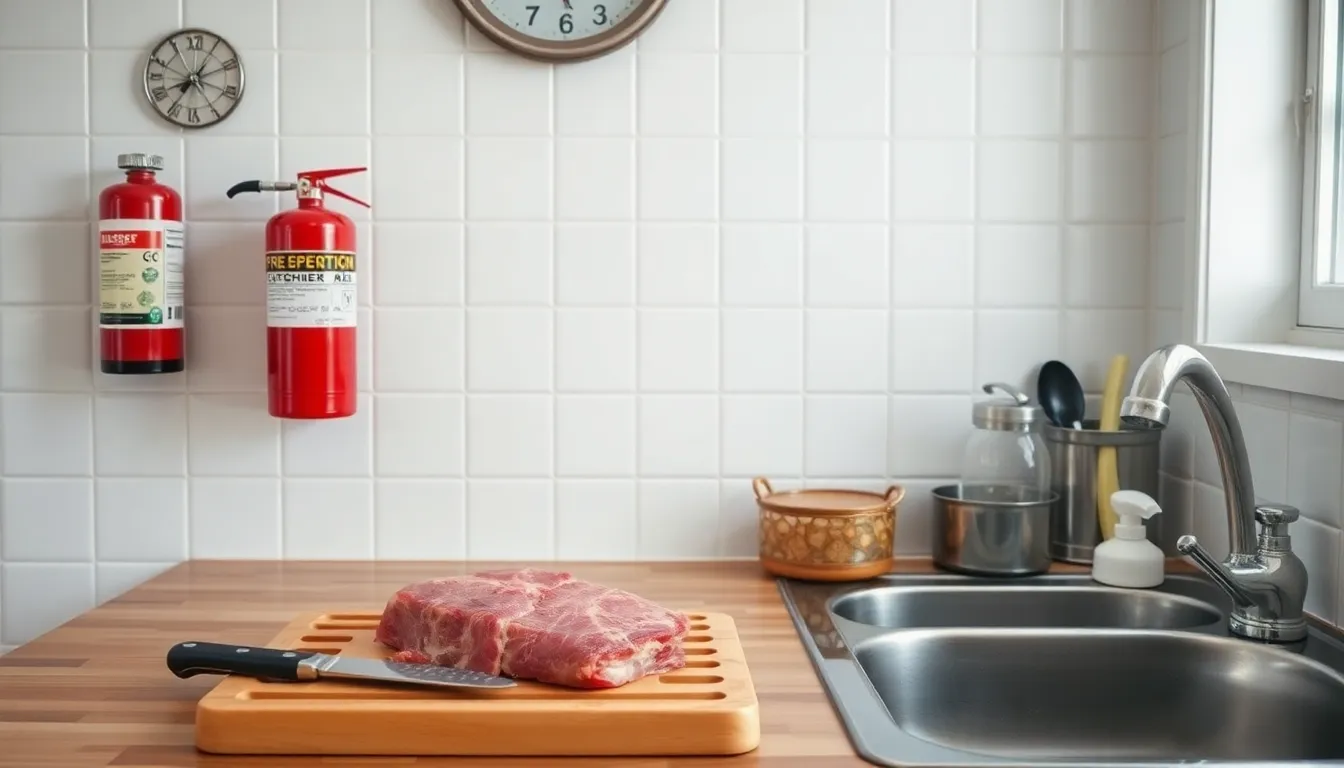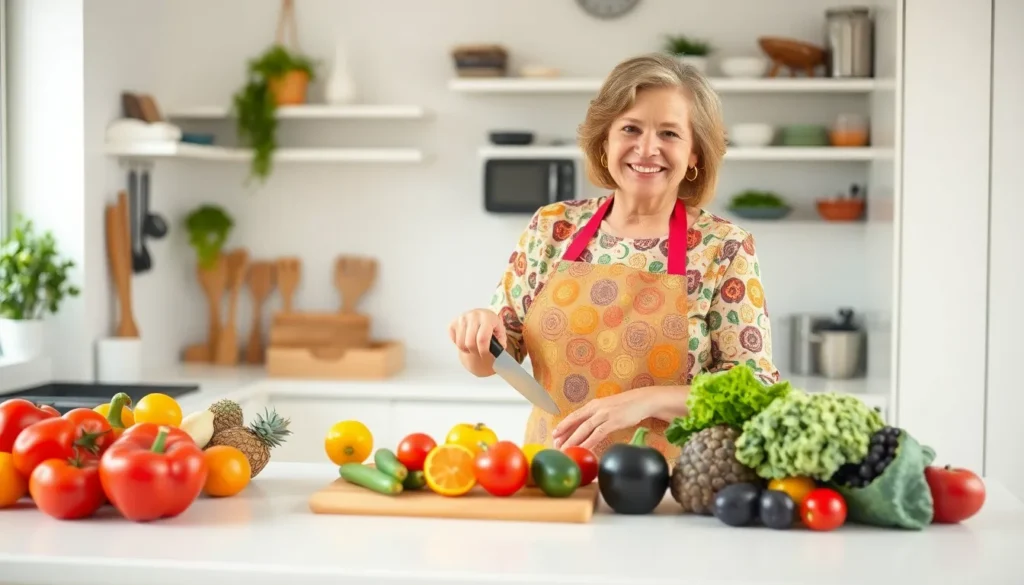Table of Contents
ToggleCooking can be a delightful adventure, but it can also turn into a kitchen nightmare if safety isn’t a priority. Picture this: you’re whipping up a gourmet meal, and suddenly, you’ve got more smoke than steak. Avoiding kitchen disasters isn’t just about avoiding the fire department; it’s about ensuring a fun and safe cooking experience for everyone involved.
Importance Of Cooking Safety Tips
Cooking safety tips serve as essential guidelines that help reduce risks in the kitchen. Prioritizing safety minimizes the chances of accidents like burns or cuts. Awareness of potential hazards plays a crucial role in maintaining a secure cooking environment.
Preventing foodborne illnesses is another vital aspect of cooking safety. Proper food handling practices—such as washing hands and cooking food to the right temperatures—help ensure meals are safe to consume. Statistics show that approximately 48 million people in the U.S. experience foodborne illnesses annually, highlighting the need for vigilance.
Using the correct equipment adds another layer of safety. Knives should be sharp, not dull, to reduce the force required during cutting. This reduction in force decreases the chances of slipping and causing injuries. Furthermore, non-slip mats can enhance stability while working in the kitchen.
Proper storage of ingredients and leftovers prevents contamination and spoilage. Labels and dates help track food freshness, reducing the likelihood of consuming expired items. A clean workspace minimizes distractions and lowers hazards, allowing for a more enjoyable cooking experience.
Understanding fire safety remains a fundamental aspect of kitchen safety. Keeping flammable items away from heat sources reduces the risk of fires. Having a fire extinguisher nearby enables quick responses in case of emergencies.
Educating everyone who cooks about safety practices ensures a collective commitment to a secure kitchen. Training in cooking safety enhances the overall experience, leading to better meal preparation and reduced accidents. Implementing these tips creates an environment where cooking stays enjoyable and safe for all involved.
Common Kitchen Hazards

Kitchen hazards can lead to serious accidents or illnesses. Awareness of specific dangers helps create a safer cooking environment.
Fire Hazards
Fire hazards rank among the top risks in any kitchen. Grease buildup on cooking surfaces can ignite and cause uncontrollable flames. Stored flammable materials, such as towels or paper products, should remain away from heat sources. Properly maintaining appliances minimizes the risk of electrical fires, while routinely checking smoke detectors enhances safety measures. It’s critical to keep fire extinguishers easily accessible and regularly check their expiration dates. Proper training in using these tools increases preparedness during a fire emergency.
Foodborne Illnesses
Foodborne illnesses pose a significant threat for approximately 48 million people in the U.S. each year. Cross-contamination occurs when raw foods contaminate ready-to-eat items, leading to severe health risks. Implementing strict handwashing practices, especially after handling raw meat, is essential. Cooking foods to their appropriate internal temperatures effectively kills harmful bacteria. Prompt refrigeration of perishable items within two hours prevents bacterial growth. Understanding and following proper food storage guidelines safeguards against illnesses, ensuring a healthier cooking experience for everyone.
Essential Cooking Safety Tips
Cooking safety is crucial for a pleasant experience in the kitchen. Following established practices minimizes risks and enhances safety.
Proper Handwashing Techniques
Handwashing serves as the first line of defense against foodborne illnesses. Hands should be washed with soap and warm water for at least 20 seconds before and after handling food. Additionally, washing hands after using the bathroom, touching pets, or handling raw meat prevents cross-contamination. Encourage everyone in the kitchen to adopt these practices, especially during meal preparation. Effectively clean under fingernails and between fingers for thorough sanitation. Keeping hand sanitizer nearby can also help maintain hygiene when soap isn’t accessible.
Safe Food Storage
Safe food storage prevents spoilage and contamination, ensuring meals remain safe. Raw meats should be stored on the bottom shelf of the refrigerator to avoid dripping onto other foods. Keeping perishable items in airtight containers reduces exposure to air and bacteria. It’s important to refrigerate leftovers within two hours to maintain freshness. Foods should be labeled with dates to ensure usage within safe time frames. Utilize the first-in, first-out method to prioritize older items. Maintaining the refrigerator temperature below 40°F helps slow bacterial growth.
Using Kitchen Tools Safely
Using kitchen tools safely enhances overall cooking experiences. Cutting boards should be stable, and using separate boards for meat and vegetables prevents cross-contamination. Ensure knives are sharp; dull knives can lead to accidents. When handling hot pots and pans, use oven mitts to avoid burns. Keeping kitchen tools clean and in good condition reduces risks associated with improper equipment. Always read the safety instructions for electrical appliances before use. Proper training on tool handling can empower everyone to cook confidently and safely.
Best Practices While Cooking
Cooking safely enhances the culinary experience and minimizes the risk of accidents. Following effective practices ensures a secure kitchen environment.
Preventing Cross-Contamination
Preventing cross-contamination is crucial in reducing foodborne illnesses. Always use separate cutting boards for raw meats and vegetables to avoid transferring harmful bacteria. Wash hands thoroughly with soap and water before and after handling any food items. Substituting single-use towels or paper towels for cleaning surfaces helps maintain hygiene. Store raw foods on lower shelves in the refrigerator to prevent juices from dripping onto other items. Using designated serving utensils instead of direct contact can also minimize risks. Adhering to these practices protects both the chef and family members from unnecessary exposure to pathogens.
Cooking Temperatures and Times
Cooking foods to the correct temperatures is essential for food safety. Use a food thermometer to check that poultry reaches an internal temperature of 165°F, while ground meats should hit 160°F. Seafood, including fish, needs to be cooked to 145°F. Vegetables should be prepared to a safe and palatable temperature of at least 135°F. Following recommended cooking times ensures that food is thoroughly prepared, reducing the risk of foodborne illnesses. Promptly refrigerating perishables within two hours of cooking prevents bacterial growth. Monitoring cooking times and temperatures safeguards health while ensuring delicious meals.
Prioritizing safety in the kitchen is essential for an enjoyable cooking experience. By implementing the tips outlined, anyone can significantly reduce risks and create a safer environment.
Awareness of hazards and proper food handling practices helps prevent accidents and foodborne illnesses. Maintaining cleanliness and using appropriate equipment further enhance safety.
Ultimately, fostering a culture of safety in the kitchen not only protects individuals but also encourages a more enjoyable cooking atmosphere for everyone involved. Making safety a priority transforms cooking from a potential hazard into a delightful and rewarding activity.




